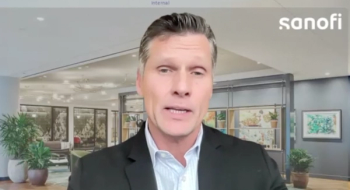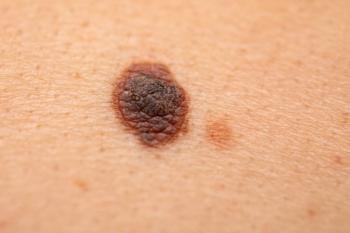
Hodgkin lymphoma: First hematologic cancer cured with immunotherapy?
Immune checkpoint inhibitors are taking the stage in treating relapsed and refractory Hodgkin lymphoma. Read more.
Functional imaging is taking a larger role in managing Hodgkin lymphoma, and immunotherapy promises to be an important tool against refractory and relapsed disease, according to experts at the 58th American Society of Hematology (ASH) Annual Meeting in San Diego.
Johnson - photo credit: Southampton University The central dilemma of Hodgkin lymphoma management is how best to balance cure probability with morbidity, said Peter M. Johnson, MA, MD, of the University of Southampton, United Kingdom, during the December 4 panel discussion, “Hodgkin Lymphoma: Treatment Today and the Challenge for Tomorrow.” That is because the likely benefits of more intense or longer therapy hinges on whether the patient’s disease is more or less aggressive. But baseline clinical factors and early functional imaging do not reliably predict aggressiveness.
One emerging strategy is response adapted therapy: using interim FDG-PET imaging to try to balance efficacy and toxicity for each patient, de-escalating or escalating treatment, Johnson said.
“Use of interim PET allows rapid testing of new approaches for the high-risk patients and those with unsatisfactory responses to existing treatments,” he said. “I regard interim FDG-PET as the standard of care in Hodgkin lymphoma.”
MoskowitzA quarter of patients with Hodgkin lymphoma experience initial treatment failure, noted Craig H. Moskowitz, MD, of the Memorial Sloan-Kettering Cancer Center in New York. While relapsed and refractory disease management is quickly entering the immunotherapy era, there is still a role for allogeneic stem cell transplantation (ASCT) for these patients, he said.
Programmed cell death-1 protein (PD-1) blockade immunotherapy releases the brakes on adaptive immunity against solid tumors, and PD-1 ligand (PD-L1) expression is a predictive biomarker of response. The resulting anti-solid-tumor immune attack is mediated by CD8+ effector T cells, and the more mutation-associated proteins a tumor makes, the easier it is for immune cells to recognize it as enemy tissue, and the stronger the anti-tumor immune response can be following checkpoint blockade, Moskowitz said.
But that’s probably not how checkpoint inhibition works with lymphoma, he said. CD8+ T-cells are not common in the Hodgkin lymphoma microenvironment, for one thing.
Yet checkpoint blockade does work with these patients. More than 500 patients with Hodgkin have been treated with nivolumab or pembrolizumab in phase 1B and phase 2 clinical trials, Moskowitz noted. More than 90% experienced some clinical benefit, with response rates of up to 70% and a complete response rate of 22%, with major toxicities being endocrine and inflammatory in nature.
The median duration of response is still unclear but exceeds a year, he said.
More is being learned each year, he noted: “There are currently 75 prospective clinical trials open at Memorial Sloan Kettering Cancer Center, studying checkpoint inhibitors in solid and liquid tumors.”
Nivolumab
Moskowitz likened immune checkpoint inhibitors to “the dogs of war”-therapies that can be given indefinitely and “really seem to work for a long time.”
“Should all transplant-eligible patients undergo high-dose therapy ASCT with the availability of checkpoint inhibitors? Maybe not,” he said. “It’s a research question.”
But for now, it is too soon in the emerging era of immunotherapy to take ASCT off the table, he believes. “Let’s remember that checkpoint inhibitors have not cured anyone of Hodgkin lymphoma yet,” he said.
Pre-transplantation PET imaging is “consistently prognostic” for ASCT, he noted.
“Pre-transplant functional imaging is the most significant determinant of outcome,” he said.
“When evaluating patients for ASCT, the two most important issues are whether there is stage 4 disease pre-salvage therapy, and if the patient is PET-negative post-salvage therapy.”
Moskowitz said that his current strategy for ASCT failures-for now-is to offer radiotherapy with curative intent to radiotherapy-naïve patients with nodal-only stage 1 or 2 Hodgkin disease. For advanced disease, Moskowitz said that he orders HLA typing and referral for potential allogeneic stem cell transplantation.
But he also now starts checkpoint inhibition therapy and continues it for three months beyond complete remission. “If complete remission is maintained, we stop therapy and monitor, and restart if Hodgkin progression occurs-and we refer back for allo transplantation consideration,” he explained.
Patients achieving a partial response on checkpoint blockade continue therapy because with checkpoint inhibition, partial responses can evolve or convert into complete responses-whereas stable disease after immunotherapy precludes complete response.
Hodgkin lymphoma has long been “a model for success” in oncology, Moskowitz noted: It was the first-recognized hematologic malignancy, the first to be cured with radiotherapy, the first cancer for which advanced disease was cured with combination chemotherapy.
Perhaps, he suggested, it will also be the first hematologic cancer to be cured with immunotherapy.
Newsletter
Get the latest industry news, event updates, and more from Managed healthcare Executive.




















































